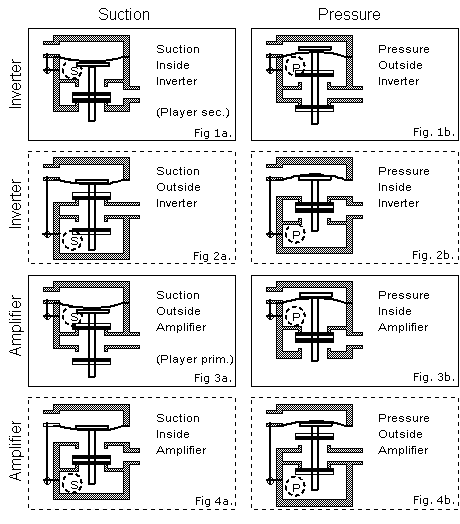| You Are Not Logged In | Login/Get New Account |
|
Please Log In. Accounts are free!
Logged In users are granted additional features including a more current version of the Archives and a simplified process for submitting articles. |
|
MMD
 Gallery
Gallery
 Tech
Tech
 pouchvalves
pouchvalves
|
|
Eight Reinvented Wheels by Johan Liljencrants email: johan.liljencrants@telia.com A valve that switches its output between supply and atmosphere basically has two valve disks and seats. The positions of the disks are set by a pouch (membrane) that senses a controlling input signal. Simple so far, but this note comes from my frustration as a novice organ designer with the question: why is every new valve idea so different from the old ones, how many ways are there really to arrange these components? It appears we have three basic binary choices:
There are a host of critical requirements to make a valve work properly, like air tightness in the valve seatings and pouch, and smooth guiding of the stem. This is covered in the literature [1,2] and can be skipped here, but except for pouch leakage. The input signal may come from the output of a similar valve. Then its pressure levels are well defined and it is relatively easy to make any of the alternatives operate. A more critical case is when the input comes from a single open/close mechanism like a pallet valve, a cutout valve, or a tracker bar. Then the closed input state of pressure/suction must be defined by use of a 'bleed', a narrow channel from the supply to the valve input. All the layouts above include the location of this bleed. In four of the cases, those in a solid frame, the bleed is in parallel with the pouch. This means that the pouch tightness is not critical, you can even implement the bleed as a small hole through the pouch although this would be bad practice giving inferior control of how much bleed flow there is. In the other four cases any pouch leakage will reduce the control pressure the bleed is trying to build up. If for instance the leak and the bleed flows are the same magnitude the pressure/suction in the pouch well is only about half the supply and the valve will likely cease to work. For this reason the four alternatives in solid
frames are the preferred ones, and we can feel content the old time player
designers probably knew what they were doing.
References:
Tue., 26 Oct. 1999 20:31:03 +0100 |
|
|
|
|
|
|
|
|
|
CONTACT FORM: Click HERE to write to the editor, or to post a message about Mechanical Musical Instruments to the MMD Unless otherwise noted, all opinions are those of the individual authors and may not represent those of the editors. Compilation copyright 1995-2026 by Jody Kravitz. Please read our Republication Policy before copying information from or creating links to this web site. Click HERE to contact the webmaster regarding problems with the website. |
|
|
||||||
|
 All
are shown in the state with zero pressure, atmosphere, as control input
to the upper left connection. The chambers connected to the supply suction/pressure
are marked with S and P respectively. Only two of the designs, as indicated,
are the ones conventionally used in player pianos. Note that the 'pouch
disk' that carries the actuating force from the pouch on to the valve stem
must be put at the correct side of the pouch. In some cases this means
the stem must penetrate the pouch. This is bad for leakage and good in
that we get a stem guide for free.
All
are shown in the state with zero pressure, atmosphere, as control input
to the upper left connection. The chambers connected to the supply suction/pressure
are marked with S and P respectively. Only two of the designs, as indicated,
are the ones conventionally used in player pianos. Note that the 'pouch
disk' that carries the actuating force from the pouch on to the valve stem
must be put at the correct side of the pouch. In some cases this means
the stem must penetrate the pouch. This is bad for leakage and good in
that we get a stem guide for free.